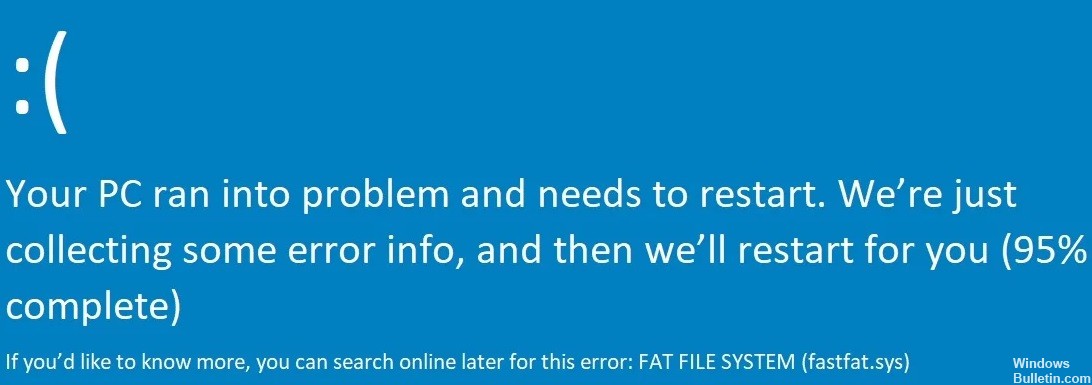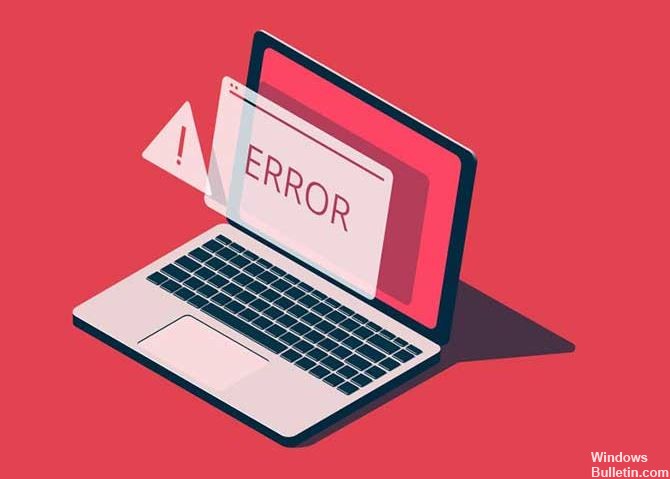Updated April 2024: Stop getting error messages and slow down your system with our optimization tool. Get it now at this link

Blue Screen of Death (BSOD) error with FAT FILE SYSTEM (fastfat.sys) restarts the operating system to prevent further damage to the system. FAT FILE SYSTEM ERROR error in Windows 10 is caused by outdated Windows operating system, outdated device drivers, corrupted system files, corrupted hard drives, conflicting folder protection/encryption applications, incorrectly triggered antivirus, and corrupted Windows operating system.
To fix this error, perform the following solution.
What Causes Error FAT FILE SYSTEM (fastfat.sys) in Windows 10

FAT file system error usually occurs after installing new hardware, updating software or system, installing a certain application, loading a system driver, etc. There are several factors that can cause Windows 10 FAT file system errors.
- Damaged, corrupt, outdated, improperly installed, or incompatible device drivers.
- Damaged file system
- Bad sectors on the hard drive
- Malicious programs or viruses
- Damaged or faulty system files
- Broken hardware
- Outdated windows
How to Repair FAT FILE SYSTEM (fastfat.sys) Error on Windows 10
You can now prevent PC problems by using this tool, such as protecting you against file loss and malware. Additionally it is a great way to optimize your computer for maximum performance.
The program fixes common errors that might occur on Windows systems with ease - no need for hours of troubleshooting when you have the perfect solution at your fingertips:
April 2024 Update:

Launch the ChkDsk command
- Boot your system in safe mode or with advanced recovery options to bring up the command line.
- From the Windows Setup screen, choose Next -> Computer Restore -> Troubleshooting -> Advanced -> Command Prompt.
- At the command prompt, type: chkdsk /f /r and press Enter.
Hardware Diagnostics
- Turn off your computer.
- Turn your computer on and immediately press the Esc key to display the boot menu.
- Press the F2 key when the Startup menu appears.
- Go to Component Testing -> Hard Disk -> Hard Disk Test.
- Go to Component Testing -> Memory -> Memory Test.
- If an error is reported during the test, repair or replace the device accordingly.
Run the Driver Test Manager
- Run the command line as an administrator.
- At the command prompt, type: verifier and press Enter.
- In the Driver Verifier Manager dialog box, select Create default settings and click Next.
- Select Automatically select all drivers installed on this computer, and then click Next.
- Windows will start checking for errors.
- Reboot your computer.
- It will start checking all the drivers installed on your computer for problems.
- If you find faulty drivers, update them.
Running the System File Checker command
- Boot into safe mode using the command line.
- Type sfc /scannow and press Enter.
- Wait for the message “Operation was successful” or “Windows resource protection detected no integrity violations” to appear, then close the command line.
- Restart the system in normal mode.
Expert Tip: This repair tool scans the repositories and replaces corrupt or missing files if none of these methods have worked. It works well in most cases where the problem is due to system corruption. This tool will also optimize your system to maximize performance. It can be downloaded by Clicking Here
Frequently Asked Questions
How do I fix a FAT file system error?
- Update Windows and drivers.
- Run the BSoD troubleshooter.
- Run the SFC scan tool.
- Run the DISM tool.
- Try to boot your computer with only one hard drive.
- Make sure your hardware is working properly.
- Remove the Folder Protect and Folder Lock software.
What is Fastfat.sys?
Fastfat.sys is a Windows driver. A driver is a small program that allows your computer to communicate with hardware or connected devices. This means that the driver has direct access to the internal components of the operating system, hardware, etc. A free forum about files can help you determine if Fastfat.
What causes a fatal error?
Fatal errors can be caused by various unexpected interactions between different programs, between programs and drivers, between programs and hardware, and by physical errors or hardware defects.
What is the FAT file system `fastfat.sys’?
FAT file system error in Windows 10 is caused by outdated Windows, outdated device drivers, corrupt system files, corrupt disks, conflicting folder protection/encryption applications, false positives from antivirus, and corrupt Windows.


